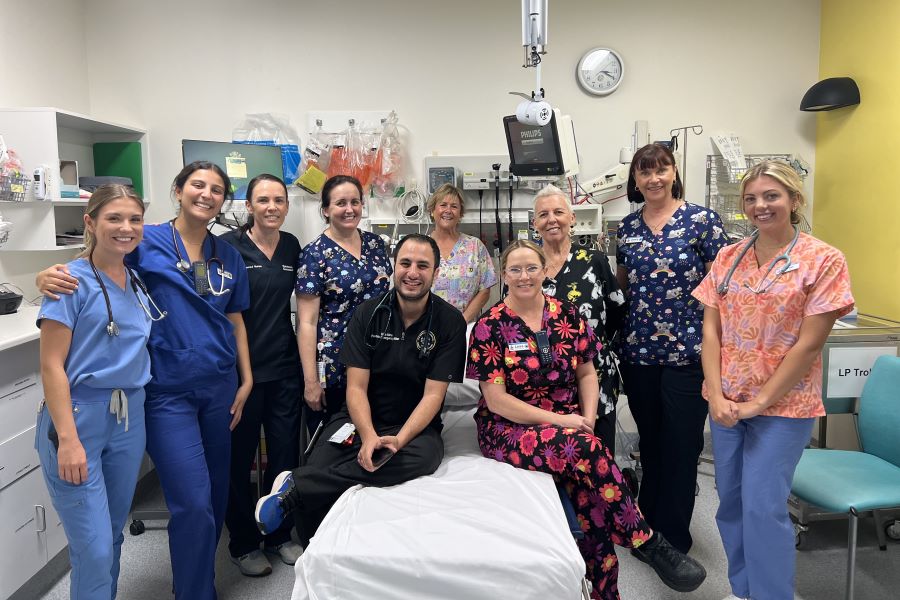Reducing complications with paediatric intravenous devices

Paediatric clinicians at The Prince Charles Hospital are a key metropolitan site in the Mini Magic Mirror study, which is aiming to reduce extravasation injuries in children.
Back row — left to right: Resident (Emergency) Dr Katie McDowell, Resident (Emergency) Dr Samar Al Shama, Clinical Nurse Emergency and Research and Project Manager MiniMAGIC MIRRORS Louise Mills, Nurse Practitioner Andrea Hetherington, Nurse Practitioner Julie Craig, Paediatric Emergency Consultant and Director of Research TPCH ED (Adults and Paediatric) Dr Faye Jordan, Registered Nurse Jenny Peak and Resident (Emergency) Dr Karen Bogle.
Front row — seated — left to right: a Paediatric Emergency Consultant and Paediatric Emergency Department Nurse Unit Manager Leisa Bauer.
Reducing extravasation injuries and other intravenous device complications is the focus of a research study involving paediatric clinicians at The Prince Charles Hospital (TPCH).

Paediatric clinicians at The Prince Charles Hospital are a key metropolitan site in the Mini Magic Mirror study, which is aiming to reduce extravasation injuries in children.
Back row — left to right: Resident (Emergency) Dr Katie McDowell, Resident (Emergency) Dr Samar Al Shama, Clinical Nurse Emergency and Research and Project Manager MiniMAGIC MIRRORS Louise Mills, Nurse Practitioner Andrea Hetherington, Nurse Practitioner Julie Craig, Paediatric Emergency Consultant and Director of Research TPCH ED (Adults and Paediatric) Dr Faye Jordan, Registered Nurse Jenny Peak and Resident (Emergency) Dr Karen Bogle.
Front row — seated — left to right: a Paediatric Emergency Consultant and Paediatric Emergency Department Nurse Unit Manager Leisa Bauer.
Extravasations are considered a top five cause of critical incidents in paediatrics. They occur when medication or fluid is accidentally delivered into a child’s tissue, rather than the vascular system, which can result in tissue necrosis and permanent scarring.
TPCH is a key metropolitan site in the larger study, which also includes paediatric clinicians from rural, remote and regional sites across Queensland. It is aiming to improve intravenous catheter selection to reduce extravasations for children.
The Magic Implementation in Rural, Remote, Metropolitan and Regional Settings (MIRRORS) exploratory study looks at current intravenous (IV) device practice, decision-making for IV device insertion in paediatric patients and tailoring interventions for future implementation to reduce extravasation injuries.
It aims to prepare metropolitan, regional and remote clinicians to use the recently released Michigan Appropriateness Guide for Intravenous Catheters (MAGIC) for our ‘mini’ patients by collecting baseline data and tailoring tools, as well as strategies for intervention, to improve safe IV selection and reduce extravasations.
Chief Investigator Professor Pauline Calleja said the MiniMAGIC MIRRORS study started with recruitment of a key stakeholder panel, representing all health disciplines and specialties involved in the selection, insertion and management of IV devices.
“A prospective cohort study then evaluated current IV device selection and extravasation injuries and identified behavioural practices by health professionals over a continuous three-month period,” Professor Calleja said.
“Research nurses worked with investigators, local educators and clinical managers to measure and quantify the clinical practices and patient outcomes related to IV device selection and care. Inserters were the local accredited workforce, not research nurses.”
An audit tool collected baseline data, and the project manager and research assistants supported sites locally.
Professor Calleja said the final phase involved exploratory qualitative interviews, inviting practitioners to semi-structured interviews to explore behavioural practices surrounding IV device selection and patient outcomes. Five clinicians from TPCH were interviewed.
“A framework is now in development to embed Mini MAGIC findings into clinical practice in paediatric sites across Queensland to improve insertion procedures and reduce extravasation injuries and other IV device related complications.”
